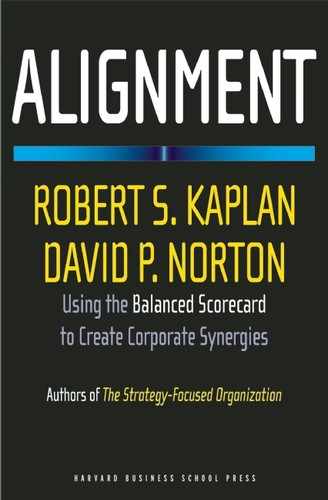PREFACE
Alignment is the fourth book in our collaboration. Our initial article, “The Balanced Scorecard: Measures That Drive Performance,” and first book, The Balanced Scorecard: Translating Strategy into Action, introduced the new approach for measuring organizational performance.1 The article and book provided guidance and examples for selecting measures in the four Balanced Scorecard perspectives, and described the emerging system for managing strategy that early adopters of the concept had used. A subsequent article, “Using the Balanced Scorecard as a Strategic Management System,” and our second book, The Strategy-Focused Organization , described how enterprises were now using the scorecard as the centerpiece of a sophisticated system to manage the execution of strategy. 2 These works, elaborating on the strategy management system introduced in the first book, identified five key principles for aligning an organization’s measurement and management systems to strategy:
- Mobilize change through executive leadership
- Translate strategy into operational terms
- Align the organization to the strategy
- Motivate to make strategy everyone’s job
- Govern to make strategy a continual process
A third book, Strategy Maps, and article, “Having Trouble with Your Strategy? Then Map It,” elaborated on Principle 2 of how to translate strategy into tangible objectives and measures.3 The book and article introduced a general framework for representing strategy through specific objectives that could be linked in cause-and-effect relationships across the four Balanced Scorecard perspectives. The framework aligned processes, people, and technology to the customer value proposition and customer and shareholder objectives.
The current book extends Principle 3: align all organizational units to the strategy. Most enterprises consist of multiple business and support units. Corporations operate diverse units under a single corporate umbrella to capture economies of scale and scope. But to achieve these benefits, the corporate headquarters needs a tool to articulate a theory for how to operate the multiple units within the corporate structure to create value beyond what the individual units could achieve on their own, without central guidance and intervention. After all, a corporate headquarters may subtract more than it adds. It incurs explicit costs through the salaries and support expenses of the corporate executive team. It also could impose implicit costs through delayed decision making and onerous reporting requirements on operating and support units. The value creation that offsets these headquarters costs must arise from aligning decentralized units to create a new source of value, which we call enterprise-derived value.
This book introduces the role for an enterprise Strategy Map and Balanced Scorecard that clarify corporate priorities, which can then be clearly communicated to each business and support unit, and also to the board of directors and key customers, suppliers, and alliance partners. Corporate headquarters subsequently examines the Strategy Maps and scorecards developed by these units to monitor whether and how the enterprise’s priorities are being implemented by each one. Used in this way, the enterprise Strategy Map and Balanced Scorecard provides corporate executives with a governance framework that helps to unlock previously unrealized value from enterprise synergies.
Beyond aligning organizational units, the primary focus of this book, the enterprise must also align employees and management processes and systems to the strategy (Principles 4 and 5 of the strategy-focused organization). For completeness purposes, we explore, in less detail, these additional two alignment processes in the final chapter of the book.
